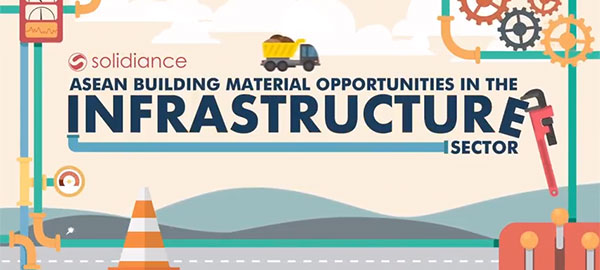Good infrastructures are a key to economic activity and development. To boost their growth, ASEAN countries are planning to invest heavily in infrastructures in the coming years: not only will they provide better transport, power and sanitation but also interesting opportunities for suppliers of building materials.
With forecasts of infrastructure spending of USD 588 billion by 2022, ASEAN economies will launch numerous new projects to drive growth, especially Indonesia, Vietnam and Malaysia. Pulled by these important investments, the building material market throughout ASEAN should receive an estimated USD 420 billion by 2022.
The following video details the estimated infrastructure spending across seven ASEAN countries and presents the involvement of stakeholder in the decision-making process and value chain. It also presents some strategies for building materials providers to succeed in obtaining new projects.
Infrastructure market in ASEAN
Here are the detailed forecasts of infrastructure spending from 2017 to 2022, according to Solidiance, with a total ASEAN of USD 588 billion for the entire ASEAN region.
Indonesia: USD 225 billion
- Road: 18%
- Bridge and tunnel: 6%
- Railway: 8%
- Airport: 3%
- Seaport: 18%
- Drainage: 10%
- Dam: 8%
- Power plant: 30%
Vietnam: USD 117 billion
- Road: 12%
- Bridge and tunnel: 2%
- Railway: 1%
- Airport: 5%
- Seaport: 5%
- Drainage: 15%
- Dam: 17%
- Power plant 42%
Malaysia: USD 88 billion
- Road: 0%
- Bridge and tunnel: 0.6%
- Railway: 23%
- Airport: 4%
- Seaport: 8%
- Drainage: 10%
- Dam: 13%
- Power plant: 13%
Thailand: USD 46 billion
- Road: 9%
- Bridge and tunnel: 4%
- Railway: 58%
- Airport: 3%
- Seaport: 0%
- Drainage: 2%
- Dam: 3%
- Power plant: 21%
Singapore: USD 44 billion
- Road: 28%
- Bridge and tunnel: 0.02%
- Railway: 46%
- Airport: 6%
- Seaport: 8%
- Drainage: 7%
- Dam: 1%
- Power plant: 5%
Philippines: USD 39 billion
- Road: 8%
- Bridge and tunnel: 3%
- Railway: 31%
- Airport: 14%
- Seaport: 25%
- Drainage: 3%
- Dam: 6%
- Power plant: 10%
Myanmar: USD 18 billion
- Road: 7%
- Bridge and tunnel: 4%
- Railway: 7%
- Airport: 5%
- Seaport: 30%
- Drainage: 1%
- Dam: 0%
- Power plant: 46%
Cambodia: USD 4 billion
Laos: USD 2 billion
Brunei: USD 1 billion
Impact on the ASEAN building materials market
With a total of USD 420 billion, the forecast of value between the different building materials in ASEAN, from 2017 to 2022, will be as follows:
- Steel: 22%
- Concrete: 27%
- Industrial equipment: 21.6%
- Coatings: 3.1%
- Asphalt: 2.7%
- Insulation: 1.5%
- Building automation: 1%
- Pipe: 1%
- Other: 10.1%
The balance of power in infrastructure project decision-making
- The government defines the infrastructure project structure. Territorial authorities tend to give authority to the main contractor to take decision about building materials.
- The main contractor is a key decision maker and influencer. Infrastructure project managers choose design and building approaches on smaller and medium-sized projects; they collaborate with design consultants and make building materials decisions.
- The consultant/architect is a primary adviser for project specifications and the choice of materials.
Tips for building materials suppliers
Government tend to choose products with the strongest track record
Building material providers who want to gain new contracts should target governments, contractors and consultants to demonstrate the success of their materials in large overseas projects. They should sponsor events and CSR activities related to infrastructure development to highlight their products’ successes.
Contractors tend to choose suppliers with whom they have established relationships
Building material providers should engage in regular visits and help contractors build up specs during the early design phases so as to build long-term relationships.
Bundled solutions can create the difference that will outperform the market
Building material suppliers should provide end-to-end solutions tailored for specific infrastructure developments and aim at taking charge of entire projects for their specialty.
Video from July 2017 by Solidiance









